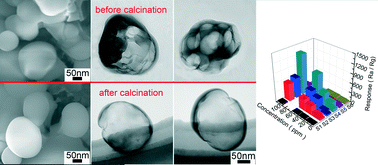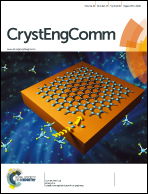Zn-doped In2O3 hollow spheres: mild solution reaction synthesis and enhanced Cl2 sensing performance†
Abstract
Zn-doped In2O3 hollow spheres have been prepared by a facile chemical route under a low temperature of 80 °C without any surfactant or template. The morphological features were characterized as self-assembled hollow spheres with a diameter of 200–300 nm, and it was observed that the amount of doped Zn significantly affects the overall morphology. Furthermore, analysis of the N2 adsorption–desorption tests showed that the Zn-doped In2O3 hollow spheres (the molar ratio of In : Zn is 9 : 1) adsorbed the largest amount of N2 and had the biggest specific surface area (26.4 m2 g−1), which contributed to the improvement of the gas sensing characteristics. Finally, the gas sensing characteristics of the obtained products were studied. The results demonstrated that the sensors based on the Zn-doped In2O3 structures exhibited a higher response to Cl2 than those without Zn and the In : Zn = 9 : 1 (molar ratio) sample showed the highest response. The sensor based on the Zn-doped In2O3 hollow spheres (the molar ratio of In : Zn is 9 : 1) exhibited the highest response of 94.7 ± 8.6 for 5 ppm Cl2. The high response, quick response-recovery behaviour and excellent stability imply good potential for practical applications. The formation mechanism and gas sensing mechanism were studied.


 Please wait while we load your content...
Please wait while we load your content...